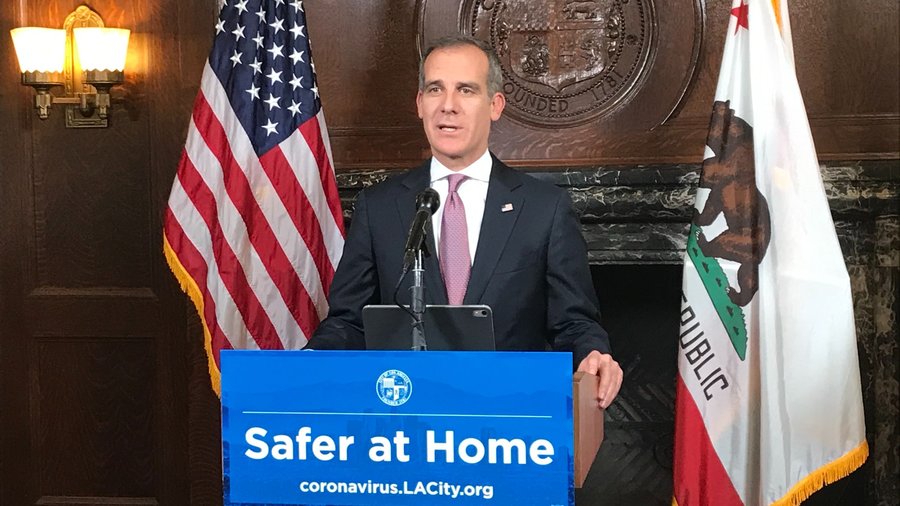Six Bay Area counties in California—Alameda, Contra Costa, Marin, San Francisco, San Mateo, and Santa Clara, along with the city of Berkeley—announced March 31 that most construction will be halted due to a tightened, joint shelter-in-place order effective at 11:59 p.m.
The mayor of Los Angeles also announced new site safety guidelines and encouraged public reporting of construction non-compliance to the city’s safer-at-home order.
The new Bay Area order says most construction, residential and commercial, is prohibited except for healthcare facility construction that relates directly to the COVID-19 response. Other exceptions include public works projects deemed essential by lead government agencies, work that secures existing construction sites and affordable housing.
“These new, stricter ordinances are a very sobering reminder of what is at stake,” says Emily Cohen, executive vice president of United Contractors (UCON). “We are working to get clarification from each local agency, Caltrans and the administration about what these stricter ordinances mean for a variety of work.”
UCON needs guidance on if, when and how contractors can work in each county and believes statewide guidance would be best. Cohen says on vital construction—including roads, bridges, highways, water infrastructure, schools, hospitals and utilities—work must continue in order to maintain and protect the state.
AGC of California expects a significant portion of members' work to be closed, but notes the California Dept. of Transportation (Caltrans) and Bay Area Rapid Transit (BART) are both continuing to operate under “essential” designation – for now.
Members are making real-time business decisions that will affect many workers, says Peter Tateishi, AGC of California CEO.
“There will be layoffs, there will be changes in employment relationships and projects put on hold,” says Tateishi, who adds the region had some “bad actors” that did not comply with COVID-19 protocol – putting employees and the public health in jeopardy. “Our members take safety seriously – they want workers to go home safely and come back the next day.”
Caltrans and BART were not immediately available for comment.
The new order says construction is defined as “essential” only if it relates to:
- the necessary maintenance, operation, or repair of essential infrastructure
- projects associated with health-care operations, including creation or expansion, as long as it is directly related to the COVID-19 response
- affordable housing that is or will be income-restricted
- public works projects if specifically defined as an essential governmental function
- shelters and temporary housing, but not including hotels or motels
- projects immediately necessary to provide critical non-commercial services to individuals experiencing homelessness, elderly persons, persons who are economically disadvantaged, and persons with special needs
- construction necessary to existing
- sites that must be shut down because of the order to be left in a safe and secure manner
- construction or repair necessary to ensure that residences and buildings containing essential businesses are safe, sanitary, or habitable to the extent such construction or repair cannot reasonably be delayed
The order supersedes earlier orders issued by the counties, which gave varying definitions of “essential” that allowed most construction to continue. All essential business must comply with social distancing protocol, which must be provided to each employee.
Meanwhile, Los Angeles Mayor Eric Garcetti issued new COVID-19 safety guidance for construction sites after reports that some jobs were not complying with the city’s safer-at-home order.
“Any worker who is sick, like everyone else in Los Angeles, must stay home,” Garcetti said at a press conference. “We will not be shy about hunting down construction that does not comply. So, comply.”
The new guidelines, issued by the Los Angeles Dept. of Building Safety, said its staff will verify compliance during regular project inspections, along with additional inspections that stem from complaints submitted to its call center or website.
Garcetti said that some complaints could provide potential rewards to the informant, adding: “Snitches get rewards."
However, the guidelines did not result from growing non-compliance, he said, adding: “No, it is not a reflection that we see more slippage, we just want to tighten the screws up."
The mayor’s office did not immediately respond to requests for further information.
Tateishi says non-complying offenders should be held accountable, but warns that reports of violations could result from observations taken out of context.
“We are not above the law – if at the end of the day people are seeing our industry or any industry out there violating the intent and the spirit of the rule and law or ordinance, we should be held accountable,” he says.
Throughout March, confusion ensued around the Bay Area and across the state as cities, counties and state officials issued differing directives and orders. Contractors, owners and construction workers struggled to interpret vague and varying language that deemed construction as “essential” work.
Gov. Gavin Newsom’s March 19 stay-at-home order mandates that all California residents stay home, except for persons working on 16 essential critical infrastructure types, as identified by the federal government, including communications, chemicals, dams, energy, transportation systems and water, among others.



